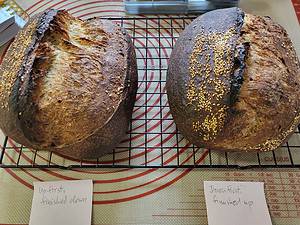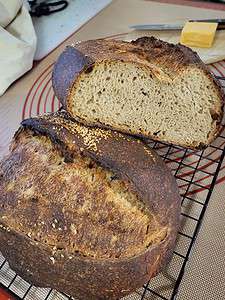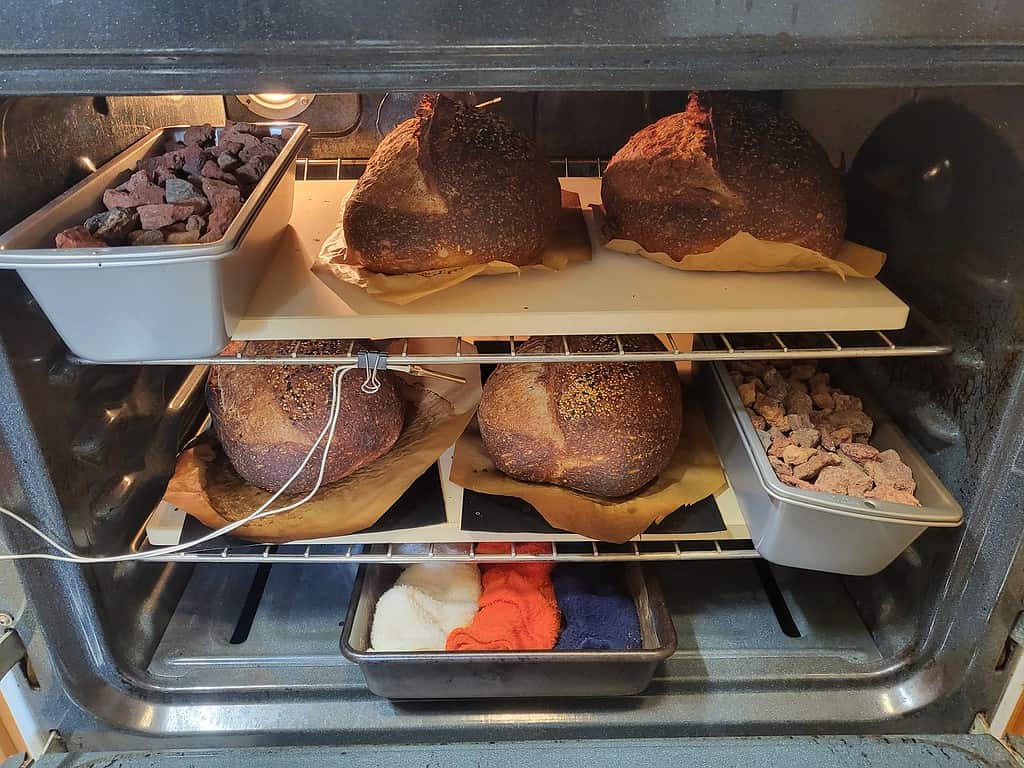
I ‘open-baked’ two 75% whole wheat sourdough loaves in my home’s oven today. To my delight, Bake #49 on 1/9/2024 was a successful bake.
Let’s chat first about Dutch Oven Bakes
Typically, I bake two such loaves in my two Cuisiland elongated Dutch ovens or bread pans. Dough hydration is usually between 77% and 80% for my 50% whole wheat sourdough loaves and my 75% whole wheat sourdough loaves, all called Brunettes.
It works well. I preheat the kitchen’s gas oven (yes, gas) with the two cast iron pots to around 500°F, which takes about an hour. In go the cold-retarded loaves straight out of the fridge, and the pot’s lids go on top to lock in the natural steam, soon evaporating out of the moist dough. I bake for 25 minutes at 475°F, take the lids off, and bake for another 15 minutes. I get perfection out of this.
Now, let’s talk Open Bake
So, why try open bake? Do I not have enough equipment? I hope to bake four or six loaves at a time − instead of two. That way, I can keep one out for immediate consumption, freeze three loaves for later, and save time and energy. However, it is more than inconvenient to fit and rotate four Dutch ovens into my kitchen oven during a bake. My kitchen’s oven has barely enough vertical space, with only four rack levels. Cast iron Dutch pots are relatively tall.

My current oven is 60cm wide. Two 20″ x 14″ steels or stones on separate racks, being able to bake two loaves each simultaneously, would make a significant difference for me. Indeed, I would have to swap loaves halfway through baking − from upper rack to lower and vice versa, but that is preferable to purchasing an expensive baking oven from Rofco, RackMaster, or Simply Bread. I do not want to consider the expense of an electrician rewiring one of my outlets for 3-phase 220 volts.
My bake #49 on 1/9/24 was an open bake. I baked two 75% whole wheat sourdough loaves: one in the bottom of a Cuisiland cast iron bread pan without using the lid on a lower rack and another on a round Cordierite pizza stone on an upper rack.

Onto the bottom of the kitchen oven, I placed a small cast iron pan and a small baking pan filled with lava rocks. I covered the oven’s vents on the top to trap any steam. After placing the cold-retarded batches of dough on the hot baking stone, I poured a liter of boiling water over the lava rocks. Uh oh, be careful; this was a hot affair for me as hot steam instantaneously rose into my face while pouring. The steam prevents the crust from setting or hardening too fast, allowing the loaves to rise sufficiently.
I preheated the kitchen oven to ~475° F, and baked the loaves for 15 minutes in steam from below. Then I took out the pans with the lava rocks and baked loaves for another 10 minutes at 475° F before switching them vertically and baking them for another 15 minutes at 450° F.

Both loaves were equally nice − with good spring, crust, ear, and crumb.
Thinking that I could bake perhaps four loaves per larger stone, I bought larger Cordierite baking stones (not steel): two of the thick Unicook Large Pizza Stone 20 Inch, Rectangular Baking Stone 20″ x 13.5″ x 0.67″, Heavy Duty Cordierite Bread Stone, at $60 each to further test open bakes. The stones are large, but not too large as 24″ wide stones would be. Steam needs some space to circulate in the oven.
I use two steel baking forms filled with lava rocks and another filled with cotton towels, all of which are treated with hot water to generate steam. The loaves sit on quality parchment paper and silicone grill mats to help prevent the bottoms from burning.

Here’s a Trick
An alternative or addition to using baking forms filled with hot water over hot lava rocks for steam could be using deep foil roaster pans to cover the loaves on baking stones. These foil pans definitely mimic, on the cheap, the use of Dutch ovens. However, employing foil pan covers might be helpful for keeping steam in what is a gas oven.
EZ Foil, a division of Reynolds Consumer Products LLC, sells a deep roaster pan (on the right) with impressive dimensions: 11 5/8 in x 9 3/8 in x 4 in or 295mm x 238mm x 101mm.

Wayfair also sells deep foil pans at https://www.wayfair.com/kitchen-tabletop/pdp/nicole-fantini-half-size-12-4-extra-deep-aluminum-foil-steam-table-roaster-pans-nfcn1598.html
This Is How Others Open Bake Sourdough Loaves
Maurizio Leo, on his The Perfect Loaf website, illustrates how to bake bread with steam in an electric home oven.

His way is just one way of ‘open’ baking, but worthwhile trying. Baking stones and a few lavarocks are a bit cheaper to purchase than cast iron bread pans and, depending on the size of the loaves, may hold a few more of them.